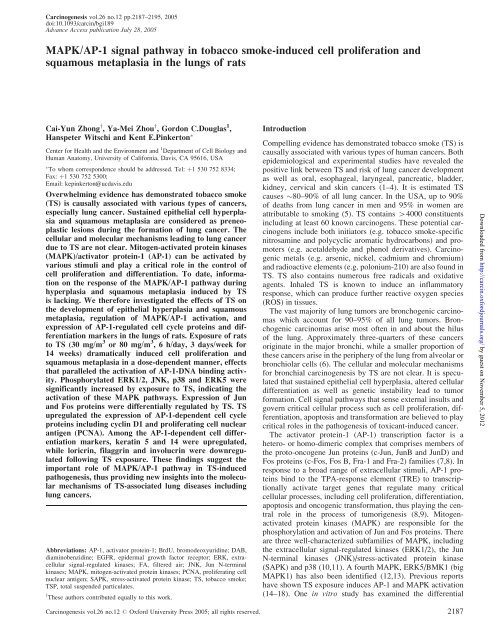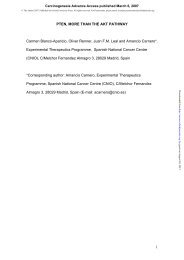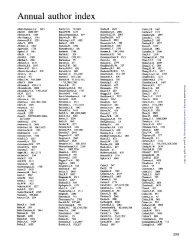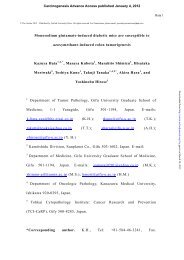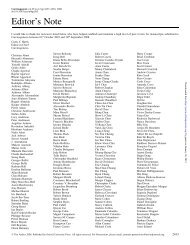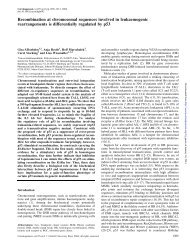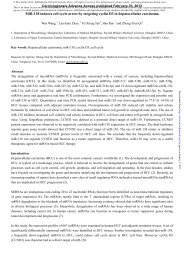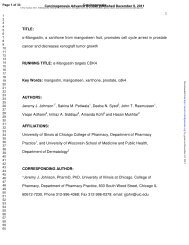MAPK/AP-1 signal pathway in tobacco smoke ... - Carcinogenesis
MAPK/AP-1 signal pathway in tobacco smoke ... - Carcinogenesis
MAPK/AP-1 signal pathway in tobacco smoke ... - Carcinogenesis
You also want an ePaper? Increase the reach of your titles
YUMPU automatically turns print PDFs into web optimized ePapers that Google loves.
Carc<strong>in</strong>ogenesis vol.26 no.12 pp.2187–2195, 2005<br />
doi:10.1093/carc<strong>in</strong>/bgi189<br />
Advance Access publication July 28, 2005<br />
<strong>M<strong>AP</strong>K</strong>/<strong>AP</strong>-1 <strong>signal</strong> <strong>pathway</strong> <strong>in</strong> <strong>tobacco</strong> <strong>smoke</strong>-<strong>in</strong>duced cell proliferation and<br />
squamous metaplasia <strong>in</strong> the lungs of rats<br />
Cai-Yun Zhong y , Ya-Mei Zhou y , Gordon C.Douglas 1 ,<br />
Hanspeter Witschi and Kent E.P<strong>in</strong>kerton<br />
Center for Health and the Environment and 1 Department of Cell Biology and<br />
Human Anatomy, University of California, Davis, CA 95616, USA<br />
To whom correspondence should be addressed. Tel: þ1 530 752 8334;<br />
Fax: þ1 530 752 5300;<br />
Email: kep<strong>in</strong>kerton@ucdavis.edu<br />
Overwhelm<strong>in</strong>g evidence has demonstrated <strong>tobacco</strong> <strong>smoke</strong><br />
(TS) is causally associated with various types of cancers,<br />
especially lung cancer. Susta<strong>in</strong>ed epithelial cell hyperplasia<br />
and squamous metaplasia are considered as preneoplastic<br />
lesions dur<strong>in</strong>g the formation of lung cancer. The<br />
cellular and molecular mechanisms lead<strong>in</strong>g to lung cancer<br />
due to TS are not clear. Mitogen-activated prote<strong>in</strong> k<strong>in</strong>ases<br />
(<strong>M<strong>AP</strong>K</strong>)/activator prote<strong>in</strong>-1 (<strong>AP</strong>-1) can be activated by<br />
various stimuli and play a critical role <strong>in</strong> the control of<br />
cell proliferation and differentiation. To date, <strong>in</strong>formation<br />
on the response of the <strong>M<strong>AP</strong>K</strong>/<strong>AP</strong>-1 <strong>pathway</strong> dur<strong>in</strong>g<br />
hyperplasia and squamous metaplasia <strong>in</strong>duced by TS<br />
is lack<strong>in</strong>g. We therefore <strong>in</strong>vestigated the effects of TS on<br />
the development of epithelial hyperplasia and squamous<br />
metaplasia, regulation of <strong>M<strong>AP</strong>K</strong>/<strong>AP</strong>-1 activation, and<br />
expression of <strong>AP</strong>-1-regulated cell cycle prote<strong>in</strong>s and differentiation<br />
markers <strong>in</strong> the lungs of rats. Exposure of rats<br />
to TS (30 mg/m 3 or 80 mg/m 3 , 6 h/day, 3 days/week for<br />
14 weeks) dramatically <strong>in</strong>duced cell proliferation and<br />
squamous metaplasia <strong>in</strong> a dose-dependent manner, effects<br />
that paralleled the activation of <strong>AP</strong>-1-DNA b<strong>in</strong>d<strong>in</strong>g activity.<br />
Phosphorylated ERK1/2, JNK, p38 and ERK5 were<br />
significantly <strong>in</strong>creased by exposure to TS, <strong>in</strong>dicat<strong>in</strong>g the<br />
activation of these <strong>M<strong>AP</strong>K</strong> <strong>pathway</strong>s. Expression of Jun<br />
and Fos prote<strong>in</strong>s were differentially regulated by TS. TS<br />
upregulated the expression of <strong>AP</strong>-1-dependent cell cycle<br />
prote<strong>in</strong>s <strong>in</strong>clud<strong>in</strong>g cycl<strong>in</strong> D1 and proliferat<strong>in</strong>g cell nuclear<br />
antigen (PCNA). Among the <strong>AP</strong>-1-dependent cell differentiation<br />
markers, kerat<strong>in</strong> 5 and 14 were upregulated,<br />
while loricr<strong>in</strong>, filaggr<strong>in</strong> and <strong>in</strong>volucr<strong>in</strong> were downregulated<br />
follow<strong>in</strong>g TS exposure. These f<strong>in</strong>d<strong>in</strong>gs suggest the<br />
important role of <strong>M<strong>AP</strong>K</strong>/<strong>AP</strong>-1 <strong>pathway</strong> <strong>in</strong> TS-<strong>in</strong>duced<br />
pathogenesis, thus provid<strong>in</strong>g new <strong>in</strong>sights <strong>in</strong>to the molecular<br />
mechanisms of TS-associated lung diseases <strong>in</strong>clud<strong>in</strong>g<br />
lung cancers.<br />
Abbreviations: <strong>AP</strong>-1, activator prote<strong>in</strong>-1; BrdU, bromodeoxyurid<strong>in</strong>e; DAB,<br />
diam<strong>in</strong>obenzid<strong>in</strong>e; EGFR, epidermal growth factor receptor; ERK, extracellular<br />
<strong>signal</strong>-regulated k<strong>in</strong>ases; FA, filtered air; JNK, Jun N-term<strong>in</strong>al<br />
k<strong>in</strong>ases; <strong>M<strong>AP</strong>K</strong>, mitogen-activated prote<strong>in</strong> k<strong>in</strong>ases; PCNA, proliferat<strong>in</strong>g cell<br />
nuclear antigen; S<strong>AP</strong>K, stress-activated prote<strong>in</strong> k<strong>in</strong>ase; TS, <strong>tobacco</strong> <strong>smoke</strong>;<br />
TSP, total suspended particulates.<br />
y<br />
These authors contributed equally to this work.<br />
Introduction<br />
Compell<strong>in</strong>g evidence has demonstrated <strong>tobacco</strong> <strong>smoke</strong> (TS) is<br />
causally associated with various types of human cancers. Both<br />
epidemiological and experimental studies have revealed the<br />
positive l<strong>in</strong>k between TS and risk of lung cancer development<br />
as well as oral, esophageal, laryngeal, pancreatic, bladder,<br />
kidney, cervical and sk<strong>in</strong> cancers (1–4). It is estimated TS<br />
causes 80–90% of all lung cancer. In the USA, up to 90%<br />
of deaths from lung cancer <strong>in</strong> men and 95% <strong>in</strong> women are<br />
attributable to smok<strong>in</strong>g (5). TS conta<strong>in</strong>s 44000 constituents<br />
<strong>in</strong>clud<strong>in</strong>g at least 60 known carc<strong>in</strong>ogens. These potential carc<strong>in</strong>ogens<br />
<strong>in</strong>clude both <strong>in</strong>itiators (e.g. <strong>tobacco</strong> <strong>smoke</strong>-specific<br />
nitrosam<strong>in</strong>e and polycyclic aromatic hydrocarbons) and promoters<br />
(e.g. acetaldehyde and phenol derivatives). Carc<strong>in</strong>ogenic<br />
metals (e.g. arsenic, nickel, cadmium and chromium)<br />
and radioactive elements (e.g. polonium-210) are also found <strong>in</strong><br />
TS. TS also conta<strong>in</strong>s numerous free radicals and oxidative<br />
agents. Inhaled TS is known to <strong>in</strong>duce an <strong>in</strong>flammatory<br />
response, which can produce further reactive oxygen species<br />
(ROS) <strong>in</strong> tissues.<br />
The vast majority of lung tumors are bronchogenic carc<strong>in</strong>omas<br />
which account for 90–95% of all lung tumors. Bronchogenic<br />
carc<strong>in</strong>omas arise most often <strong>in</strong> and about the hilus<br />
of the lung. Approximately three-quarters of these cancers<br />
orig<strong>in</strong>ate <strong>in</strong> the major bronchi, while a smaller proportion of<br />
these cancers arise <strong>in</strong> the periphery of the lung from alveolar or<br />
bronchiolar cells (6). The cellular and molecular mechanisms<br />
for bronchial carc<strong>in</strong>ogenesis by TS are not clear. It is speculated<br />
that susta<strong>in</strong>ed epithelial cell hyperplasia, altered cellular<br />
differentiation as well as genetic <strong>in</strong>stability lead to tumor<br />
formation. Cell <strong>signal</strong> <strong>pathway</strong>s that sense external <strong>in</strong>sults and<br />
govern critical cellular process such as cell proliferation, differentiation,<br />
apoptosis and transformation are believed to play<br />
critical roles <strong>in</strong> the pathogenesis of toxicant-<strong>in</strong>duced cancer.<br />
The activator prote<strong>in</strong>-1 (<strong>AP</strong>-1) transcription factor is a<br />
hetero- or homo-dimeric complex that comprises members of<br />
the proto-oncogene Jun prote<strong>in</strong>s (c-Jun, JunB and JunD) and<br />
Fos prote<strong>in</strong>s (c-Fos, Fos B, Fra-1 and Fra-2) families (7,8). In<br />
response to a broad range of extracellular stimuli, <strong>AP</strong>-1 prote<strong>in</strong>s<br />
b<strong>in</strong>d to the TPA-response element (TRE) to transcriptionally<br />
activate target genes that regulate many critical<br />
cellular processes, <strong>in</strong>clud<strong>in</strong>g cell proliferation, differentiation,<br />
apoptosis and oncogenic transformation, thus play<strong>in</strong>g the central<br />
role <strong>in</strong> the process of tumorigenesis (8,9). Mitogenactivated<br />
prote<strong>in</strong> k<strong>in</strong>ases (<strong>M<strong>AP</strong>K</strong>) are responsible for the<br />
phosphorylation and activation of Jun and Fos prote<strong>in</strong>s. There<br />
are three well-characterized subfamilies of <strong>M<strong>AP</strong>K</strong>, <strong>in</strong>clud<strong>in</strong>g<br />
the extracellular <strong>signal</strong>-regulated k<strong>in</strong>ases (ERK1/2), the Jun<br />
N-term<strong>in</strong>al k<strong>in</strong>ases (JNK)/stress-activated prote<strong>in</strong> k<strong>in</strong>ase<br />
(S<strong>AP</strong>K) and p38 (10,11). A fourth <strong>M<strong>AP</strong>K</strong>, ERK5/BMK1 (big<br />
<strong>M<strong>AP</strong>K</strong>1) has also been identified (12,13). Previous reports<br />
have shown TS exposure <strong>in</strong>duces <strong>AP</strong>-1 and <strong>M<strong>AP</strong>K</strong> activation<br />
(14–18). One <strong>in</strong> vitro study has exam<strong>in</strong>ed the differential<br />
Carc<strong>in</strong>ogenesis vol.26 no.12 # Oxford University Press 2005; all rights reserved. 2187<br />
Downloaded from<br />
http://carc<strong>in</strong>.oxfordjournals.org/ by guest on November 5, 2012
C.-Y.Zhong et al.<br />
expression of Jun (c-Jun, JunB and JunD) and Fos (c-Fos,<br />
Fos B, Fra-1 and Fra-2 ) prote<strong>in</strong> families (17). In vivo studies,<br />
however, primarily exam<strong>in</strong>ed the effects of TS on c-Jun and<br />
c-Fos expression, little is known regard<strong>in</strong>g other members of<br />
the <strong>AP</strong>-1 family. Information on the response of the new<br />
member of <strong>M<strong>AP</strong>K</strong>, ERK5, to TS is also unknown s<strong>in</strong>ce previous<br />
studies exam<strong>in</strong>ed only the three classic <strong>M<strong>AP</strong>K</strong> <strong>pathway</strong>s.<br />
Evidence also reveals that TS <strong>in</strong>duces the expression of cycl<strong>in</strong><br />
D1 and PCNA, the <strong>AP</strong>-1 target genes <strong>in</strong>volved <strong>in</strong> promot<strong>in</strong>g<br />
cell cycle progression (15,19). No studies, however, have been<br />
done to <strong>in</strong>vestigate <strong>AP</strong>-1 target cell differentiation genes <strong>in</strong><br />
TS-<strong>in</strong>duced squamous cell metaplasia.<br />
This study was designed to <strong>in</strong>vestigate the regulation and<br />
role of the <strong>M<strong>AP</strong>K</strong>/<strong>AP</strong>-1 <strong>signal</strong> <strong>pathway</strong> <strong>in</strong> TS-<strong>in</strong>duced lung<br />
epithelial hyperplasia and squamous cell metaplasia. We demonstrate<br />
that exposure to TS <strong>in</strong>duces pulmonary epithelial cell<br />
proliferation and squamous metaplasia <strong>in</strong> a dose-dependent<br />
manner, and that activation of the <strong>M<strong>AP</strong>K</strong>/<strong>AP</strong>-1 <strong>pathway</strong> and<br />
dysregulation of <strong>AP</strong>-1 target cell cycle prote<strong>in</strong>s as well as<br />
differentiation markers are implicated <strong>in</strong> the <strong>in</strong>duction of<br />
these deleterious lesions. These f<strong>in</strong>d<strong>in</strong>gs <strong>in</strong>dicate the important<br />
role of <strong>M<strong>AP</strong>K</strong>/<strong>AP</strong>-1 <strong>in</strong> the development of TS-<strong>in</strong>duced<br />
pathogenesis.<br />
Materials and methods<br />
Chemicals and reagents<br />
Bromodeoxyurid<strong>in</strong>e (BrdU) was purchased from Sigma-Aldrich (St Louis,<br />
MO). Diam<strong>in</strong>obenzid<strong>in</strong>e (DAB) substrate kit was from Zymed Laboratories<br />
(South San Francisco, CA). [g- 32 P]dATP was from Amersham Pharma<br />
Biotech (Piscataway, NJ). <strong>AP</strong>-1 consensus oligonucleotides and T4 polynucleotide<br />
k<strong>in</strong>ase were from Promega (Madison, WI). Mouse monoclonal<br />
anti-BrdU primary antibody was from Roch Applied Science (Indianapolis,<br />
IN). Antibodies to phospho-ERK1/2, phospho-JNK/S<strong>AP</strong>K, phospho-p38 and<br />
phospho-ERK5 were from Cell Signal<strong>in</strong>g Technology (Beverly, MA). Antibodies<br />
to c-Jun, JunB, JunD, c-Fos, FosB, Fra-1, Fra-2, cycl<strong>in</strong> D1, PCNA and<br />
<strong>in</strong>volucr<strong>in</strong> were from Santa Cruz Biotechnology (Santa Cruz, CA). Antibodies<br />
to kerat<strong>in</strong> 5, kerat<strong>in</strong> 14, loricr<strong>in</strong> and filaggr<strong>in</strong> were from Covance Research<br />
Products (Berkeley, CA).<br />
Animals<br />
Twelve-week-old male spontaneously hypertensive (SH) rats (derived from<br />
Wistar–Kyoto rats by phenotypic segregation of the hypertensive trait and<br />
<strong>in</strong>breed<strong>in</strong>g) weigh<strong>in</strong>g 260–310 g were purchased from Charles River<br />
Laboratories (Raleigh, NC). This stra<strong>in</strong> of rats was selected based on previous<br />
studies, completed <strong>in</strong> our laboratory, to demonstrate these rats to be highly<br />
sensitive to the effects of TS exposure, with a significant <strong>in</strong>duction of squamous<br />
cell metaplasia <strong>in</strong> the epithelium of the <strong>in</strong>trapulmonary airways (20). All<br />
rats were allowed to acclimate for 1 week prior to the onset of experimental<br />
exposure. The rats were housed <strong>in</strong> polypropylene cages, ma<strong>in</strong>ta<strong>in</strong>ed on a<br />
12-hour light/dark cycle, and provided water and rat chow ad libitum. Animals<br />
were handled <strong>in</strong> accordance with standards established by the US Animal<br />
Welfare Acts as set forth <strong>in</strong> the National Institutes of Health Guidel<strong>in</strong>es and<br />
by the University of California, Davis, Animal Care and Use Committee.<br />
TS exposure<br />
Rats were exposed to a mixture of sidestream and ma<strong>in</strong>stream cigarette <strong>smoke</strong><br />
<strong>in</strong> a smok<strong>in</strong>g apparatus built <strong>in</strong> our laboratory (21). The cigarettes were<br />
humidified 1R4F research cigarettes (Tobacco Health Research Institute,<br />
Lex<strong>in</strong>gton, KY). An automatic metered puffer was used to <strong>smoke</strong> the cigarettes<br />
under Federal Trade Commission conditions (35 ml puff, 2 s duration, 1 puff<br />
per m<strong>in</strong>). The <strong>smoke</strong> was collected <strong>in</strong> a chimney, diluted with filtered air (FA),<br />
and delivered to whole-body exposure chambers. The exposures were characterized<br />
for the three major constituents of cigarette <strong>smoke</strong>: nicot<strong>in</strong>e, carbon<br />
monoxide and total suspended particulates (TSP). Animals were exposed for<br />
6 h/day, 3 days/week for a total of 14 weeks. This exposure regimen was<br />
selected based on earlier studies that demonstrated this stra<strong>in</strong> of rats better<br />
tolerated exposure to a high level of particulate matter <strong>smoke</strong> for prolonged<br />
periods of time with exposure be<strong>in</strong>g 3 days/week rather than 5 days/week.<br />
Carbon monoxide was measured every 30 m<strong>in</strong>, TSP every 2 h and nicot<strong>in</strong>e<br />
per day (approximately midway through the exposure period). Experiments<br />
2188<br />
consisted of animals exposed to only FA (control), a low concentration of TS<br />
(30 mg/m 3 TSP) and a high concentration of TS (80 mg/m 3 TSP).<br />
Tissue preparation<br />
Two hours prior to necropsy, each rat received an <strong>in</strong>traperitoneal <strong>in</strong>jection of<br />
BrdU 20 mg/kg body wt, a nucleotide analog used to identify cells undergo<strong>in</strong>g<br />
DNA synthesis. At necropsy, animals were anesthetized with an overdose of<br />
sodium pentobarbital. The trachea was cannulated and the chest cavity opened<br />
by a midl<strong>in</strong>e <strong>in</strong>cision. The right lung was frozen <strong>in</strong> liquid nitrogen, and stored<br />
at 80 C until use. The left lung was <strong>in</strong>flation-fixed by <strong>in</strong>tratracheal <strong>in</strong>stillation<br />
of 4% buffered z<strong>in</strong>c formal<strong>in</strong> (Z-Fix) at 30 cm of water pressure for 1 h,<br />
and stored <strong>in</strong> 70% ethanol before process<strong>in</strong>g. Transverse slices were cut<br />
immediately cranial and caudal to the hilus of the left lung, dehydrated <strong>in</strong> a<br />
graded ethanol series, and embedded <strong>in</strong> paraff<strong>in</strong> for use <strong>in</strong> immunohistochemical<br />
and morphormetric studies.<br />
This tissue sampl<strong>in</strong>g strategy allowed for exam<strong>in</strong>ation of the central axial<br />
airway, distal airways as well as lung parenchyma. Tissue sections were<br />
prepared us<strong>in</strong>g a HM 355 rotary microtome (Carl Zeiss, Thornwood, NY).<br />
A small piece of <strong>in</strong>test<strong>in</strong>e from each rat was used as a label<strong>in</strong>g control for BrdU<br />
immunosta<strong>in</strong><strong>in</strong>g. Sections 5 mm thick were placed on Superfrost Plus glass<br />
slides.<br />
Immunohistochemistry for BrdU<br />
Tissue sections were deparaff<strong>in</strong>ized <strong>in</strong> xylene and hydrated <strong>in</strong> a graded ethanol<br />
series, respectively. Endogenous peroxidase activity was blocked with 3%<br />
hydrogen peroxide for 30 m<strong>in</strong> at room temperature, followed by <strong>in</strong>cubation<br />
with 0.1% protease for 3 m<strong>in</strong>. Follow<strong>in</strong>g non-specific block<strong>in</strong>g <strong>in</strong> 10% horse<br />
serum, sections were <strong>in</strong>cubated with mouse monoclonal anti-BrdU primary<br />
antibody for 1 h at 37 C. Sections were subsequently <strong>in</strong>cubated <strong>in</strong> biot<strong>in</strong>ylated<br />
horse anti-mouse secondary antibody followed by ABC reagent from a<br />
Vectasta<strong>in</strong> ABC kit (Vector, Burl<strong>in</strong>game, CA), each for 30 m<strong>in</strong> at room<br />
temperature. DAB was used as chromogen substrate, then countersta<strong>in</strong>ed<br />
with nuclear fast red.<br />
Label<strong>in</strong>g <strong>in</strong>dices were determ<strong>in</strong>ed for the central axial airway, distal airways<br />
down to term<strong>in</strong>al bronchioles and lung parenchyma. Term<strong>in</strong>al bronchioles<br />
were def<strong>in</strong>ed as the last conduct<strong>in</strong>g airway open<strong>in</strong>g <strong>in</strong>to an alveolar duct.<br />
Exam<strong>in</strong>ation of the lung parenchyma was done by select<strong>in</strong>g non-overlapp<strong>in</strong>g<br />
fields <strong>in</strong>itiated by random start and subsequent stage movement across parenchymal<br />
tissues <strong>in</strong> a zigzag pattern.<br />
Intest<strong>in</strong>e tissue from each rat was sta<strong>in</strong>ed for BrdU label<strong>in</strong>g simultaneously,<br />
and the <strong>in</strong>tense sta<strong>in</strong><strong>in</strong>g <strong>in</strong> the <strong>in</strong>test<strong>in</strong>e of each animal served as the positive<br />
control for BrdU label<strong>in</strong>g. A negative control was also performed us<strong>in</strong>g mouse<br />
IgG. In each region, 500–1000 cells per lung were counted. The label<strong>in</strong>g <strong>in</strong>dex<br />
was expressed as a percentage of BrdU-positive cells.<br />
Preparation of lung cytosolic and nuclear prote<strong>in</strong> extracts<br />
The method for the preparation of lung cytosolic and nuclear prote<strong>in</strong> extracts<br />
has been described previously (22). Briefly, immediately follow<strong>in</strong>g deep<br />
anesthesia, the right lung lobes were removed, frozen <strong>in</strong> liquid nitrogen, and<br />
stored <strong>in</strong> 80 C. The lungs were homogenized <strong>in</strong> ice-cold Tris–HCl buffer<br />
(25 mM Tris, 1 mM EDTA, 10% glycerol and 1 mM DTT, pH 7.4) with a glass<br />
homogenizer. The homogenate was centrifuged at 10 000 g for 20 m<strong>in</strong> at 4 C.<br />
The supernatant conta<strong>in</strong><strong>in</strong>g cytosolic prote<strong>in</strong> was aliquoted and stored at<br />
80 C. The crude nuclear fraction <strong>in</strong> the pellet was washed three times with<br />
homogenate buffer conta<strong>in</strong><strong>in</strong>g Triton X-100, followed by wash<strong>in</strong>g one time<br />
without Triton X-100. Nuclear prote<strong>in</strong> was extracted with buffer C (20 mM<br />
HEPES, 25% glycerol, 0.42 M NaCl and 1 mM EDTA) by centrifugation<br />
at 50 000 g for 30 m<strong>in</strong>. Prote<strong>in</strong> concentration was measured by a modified<br />
Bradford assay accord<strong>in</strong>g to the manufacturer’s <strong>in</strong>structions (Bio-Rad,<br />
Hercules, CA) with bov<strong>in</strong>e serum album<strong>in</strong> as standard.<br />
Western blot analysis<br />
Western blot analyses were used to measure the prote<strong>in</strong> levels of phospho-<br />
ERK1/2, phospho-JNK, phospho-p38, phospho-ERK5, c-Jun, JunB, JunD,<br />
c-Fos, Fos B, Fra-1, Fra-2, cycl<strong>in</strong> D1, PCNA, kerat<strong>in</strong> 5, kerat<strong>in</strong> 14, loricr<strong>in</strong>,<br />
filaggr<strong>in</strong> and <strong>in</strong>volucr<strong>in</strong>. Fifty micrograms of cytosolic or nuclear prote<strong>in</strong>s<br />
were loaded and separated on 10–12% SDS–PAGE, followed by transblott<strong>in</strong>g<br />
to an ImmunBlot PVDF membrane (Bio-Rad, Hercules, CA). The membrane<br />
was subsequently probed with primary antibody at a dilution of 1:1000.<br />
Horseradish peroxidase-conjugated secondary antibody was added at a dilution<br />
of 1:3000. The blots were subsequently developed us<strong>in</strong>g an enhanced chemilum<strong>in</strong>escence<br />
detection kit (Amersham Pharmacia Biotech). Follow<strong>in</strong>g exposure<br />
on autoradiography film, immunoreactive prote<strong>in</strong> bands were quantified<br />
by densitometry. b-act<strong>in</strong> served as the load<strong>in</strong>g control.<br />
Electrophoretic mobility shift assay (EMSA)<br />
EMSA was performed to determ<strong>in</strong>e <strong>AP</strong>-1–DNA b<strong>in</strong>d<strong>in</strong>g activity. The oligonucleotide<br />
used as a probe was double-stranded DNA conta<strong>in</strong><strong>in</strong>g <strong>AP</strong>-1<br />
Downloaded from<br />
http://carc<strong>in</strong>.oxfordjournals.org/ by guest on November 5, 2012
Fig. 1. Micrograph of lung tissue sections with BrdU immunohistochemical sta<strong>in</strong><strong>in</strong>g of proliferat<strong>in</strong>g cells. Regions <strong>in</strong>clude the central airway (A),<br />
distal airway (B) and lung parenchyma (C). Lung tissues were from rats exposed to FA, 30 or 80 mg/m 3 TS. Proliferat<strong>in</strong>g cells were<br />
identified as darkly sta<strong>in</strong>ed with BrdU, as <strong>in</strong>dicated by arrow. Magnification: 250 .<br />
consensus sequence labeled with [g- 32 P]dATP us<strong>in</strong>g T4 polynucleotide k<strong>in</strong>ase.<br />
The b<strong>in</strong>d<strong>in</strong>g reaction of nuclear prote<strong>in</strong>s to the probe was assessed by <strong>in</strong>cubation<br />
of mixtures conta<strong>in</strong><strong>in</strong>g 5 mg nuclear prote<strong>in</strong>, 0.5 mg poly (dIƒdC) and<br />
40 000 c.p.m. 32 P- labeled probe <strong>in</strong> the b<strong>in</strong>d<strong>in</strong>g buffer (7.5 mM HEPES, pH 7.6,<br />
35 mM NaCl, 1.5 mM MgCl2, 0.05 mM EDTA, 1 mM DTT and 7.5% glycerol)<br />
for 30 m<strong>in</strong> at 25 C. For the competitive assay, excessive unlabeled oligonucleotides<br />
were <strong>in</strong>cubated with prote<strong>in</strong>s prior to the addition of radiolabeled<br />
probe. Prote<strong>in</strong>-DNA b<strong>in</strong>d<strong>in</strong>g complex was separated by 5% polyacrylamide<br />
gel electrophoresis and autoradiographed overnight.<br />
Exam<strong>in</strong>ation of epithelial cell squamous metaplasia<br />
Sections of the paraff<strong>in</strong>-embedded left lung were cut at a thickness of 5 mm.<br />
All sections were sta<strong>in</strong>ed with hematoxyl<strong>in</strong> and eos<strong>in</strong>. Structures exam<strong>in</strong>ed<br />
<strong>in</strong>cluded the central axial airway, distal airways down to term<strong>in</strong>al bronchioles<br />
and lung parenchyma. Epithelial composition cover<strong>in</strong>g the basal lam<strong>in</strong>a of<br />
each airway was classified as either simple-to-pseudostratified columnar or<br />
stratified squamous. Simple or pseudostratified columnar epithelium consists<br />
of ciliated, mucous and basal cells l<strong>in</strong><strong>in</strong>g the basal lam<strong>in</strong>a of the airway.<br />
Stratified squamous epithelium consisted of mixed flattened, elongated cells<br />
of vary<strong>in</strong>g degrees <strong>in</strong> multiple layers with dist<strong>in</strong>ct stratification.<br />
Statistical analysis<br />
Statistical analyses were performed us<strong>in</strong>g Statview statistical software (SAS<br />
Institute, Cary, NC). All data were expressed as mean SE. Comparisons<br />
among TS-exposed and FA-exposed groups were made by ANOVA followed<br />
by Fisher’s protected least significant difference post hoc multiple comparisons.<br />
A value of P 5 0.05 was considered to be significantly different.<br />
Results<br />
TS <strong>in</strong>duces cell proliferation <strong>in</strong> the lungs of rats<br />
To exam<strong>in</strong>e the effect of TS on cell proliferation <strong>in</strong> the lungs of<br />
rats, immunohistochemistry for BrdU with<strong>in</strong> specific anatomical<br />
sites was performed for the central axial airway, distal<br />
airways and lung parenchyma. These studies demonstrated a<br />
strik<strong>in</strong>g <strong>in</strong>duction <strong>in</strong> cell proliferation of the airways <strong>in</strong> rats<br />
follow<strong>in</strong>g 14 weeks of TS exposure. The majority of proliferat<strong>in</strong>g<br />
cells <strong>in</strong> the central airway were basal cells. In distal<br />
airways, the proliferat<strong>in</strong>g cells <strong>in</strong>cluded basal cells and epithelial<br />
cells. In the lung parenchyma, the proliferat<strong>in</strong>g cells<br />
<strong>M<strong>AP</strong>K</strong>/<strong>AP</strong>-1 <strong>pathway</strong> <strong>in</strong> TS-<strong>in</strong>duced pathogenesis<br />
Fig. 2. BrdU label<strong>in</strong>g <strong>in</strong>dex with<strong>in</strong> the regions of the central airway, distal<br />
airway and parenchyma of the lungs. The label<strong>in</strong>g <strong>in</strong>dex is expressed as<br />
the percentage of BrdU-positive cells. Data are shown as means SE<br />
(n ¼ 6). P 5 0.05, compared with FA; P 5 0.01, compared with FA.<br />
appeared to be primarily epithelial cells (Figure 1). BrdU<br />
label<strong>in</strong>g <strong>in</strong>dices for the central airway, distal airways and<br />
lung parenchyma are shown <strong>in</strong> Figure 2. At a concentration<br />
of 80 mg/m 3 , TS markedly <strong>in</strong>creased BrdU label<strong>in</strong>g <strong>in</strong>dices <strong>in</strong><br />
the central airway (40-fold) and distal airways (33-fold). BrdU<br />
label<strong>in</strong>g <strong>in</strong>dex <strong>in</strong> the lung parenchyma was not significantly<br />
<strong>in</strong>creased follow<strong>in</strong>g 80 mg/m 3 of TS exposure. In contrast to<br />
the dramatic <strong>in</strong>duction of cell proliferation by 80 mg/m 3 of TS<br />
exposure, no significant <strong>in</strong>creases <strong>in</strong> BrdU label<strong>in</strong>g <strong>in</strong>dex for<br />
all anatomical regions exam<strong>in</strong>ed were noted follow<strong>in</strong>g exposure<br />
to 30 mg/m 3 of TS.<br />
2189<br />
Downloaded from<br />
http://carc<strong>in</strong>.oxfordjournals.org/ by guest on November 5, 2012
C.-Y.Zhong et al.<br />
<strong>AP</strong>-1-DNA b<strong>in</strong>d<strong>in</strong>g activity is <strong>in</strong>creased by TS<br />
<strong>AP</strong>-1 is the major transcription factor that is crucial <strong>in</strong> the<br />
control of a number of <strong>signal</strong> transduction cascades <strong>in</strong>clud<strong>in</strong>g<br />
cell growth. To exam<strong>in</strong>e the effect of TS exposure on <strong>AP</strong>-1<br />
activation, <strong>AP</strong>-1-DNA b<strong>in</strong>d<strong>in</strong>g activity was measured <strong>in</strong> lung<br />
tissue nuclear extract by EMSA. Consistent with BrdU<br />
immunohistochemical sta<strong>in</strong><strong>in</strong>g, exposure to 30 mg/m 3 of TS<br />
did not significantly change <strong>AP</strong>-1-DNA b<strong>in</strong>d<strong>in</strong>g activity <strong>in</strong><br />
lung tissues. In contrast, exposure of animals to 80 mg/m 3 of<br />
TS resulted <strong>in</strong> a significant <strong>in</strong>crease <strong>in</strong> <strong>AP</strong>-1-DNA b<strong>in</strong>d<strong>in</strong>g<br />
activity (P 5 0.01) (Figure 3).<br />
Differential changes of <strong>AP</strong>-1 subunits by TS<br />
<strong>AP</strong>-1 is composed of either homo- or hetero-dimers between<br />
members of Jun and Fos families. Expression of <strong>AP</strong>-1 subunits<br />
is differentially regulated <strong>in</strong> response to various stimuli. To<br />
exam<strong>in</strong>e the effects of TS exposure on the expression of <strong>AP</strong>-1<br />
subunits, the nuclear prote<strong>in</strong> levels of Jun and Fos family<br />
Fig. 3. Effects of TS on <strong>AP</strong>-1 activation. (A) Electrophoretic mobility<br />
shift assay of <strong>AP</strong>-1-DNA b<strong>in</strong>d<strong>in</strong>g activity <strong>in</strong> rat lungs. Lane 1, competition<br />
assay; lanes 2–5, FA; lanes 6–9, 30 mg/m 3 TS; lanes 10–13, 80 mg/m 3 TS.<br />
(B) Densitometry of <strong>AP</strong>-1-DNA b<strong>in</strong>d<strong>in</strong>g activity. Data are expressed<br />
as mean SE (n ¼ 4). P 5 0.01, compared with FA.<br />
members were measured by western blot analysis. As shown<br />
<strong>in</strong> Figure 4, significant <strong>in</strong>creases <strong>in</strong> c-Jun (P 5 0.05) and Jun D<br />
(P 5 0.01) were noted <strong>in</strong> animals exposed to 80 mg/m 3 of TS<br />
when compared with FA controls, while the level of Jun B was<br />
decreased <strong>in</strong> these animals. The expression of Fos family<br />
members, <strong>in</strong>clud<strong>in</strong>g c-Fos, Fos B and Fra-2 were upregulated<br />
follow<strong>in</strong>g 80 mg/m 3 of TS exposure (Figure 5). The expression<br />
level of Fra-1 was undetectable <strong>in</strong> animals exposed to either<br />
TS or FA. No significant changes were observed for Jun and<br />
Fos prote<strong>in</strong>s <strong>in</strong> animals exposed to 30 mg/m 3 of TS.<br />
TS activates <strong>AP</strong>-1 through ERK1/2/JNK/p38/ERK5 <strong>pathway</strong>s<br />
Activation of <strong>AP</strong>-1 is triggered through dist<strong>in</strong>ct <strong>pathway</strong>s <strong>in</strong><br />
response to various stimuli. In order to better understand the<br />
underly<strong>in</strong>g mechanism of TS <strong>in</strong> <strong>in</strong>duc<strong>in</strong>g cell proliferation and<br />
<strong>AP</strong>-1 activation, <strong>AP</strong>-1 activation <strong>pathway</strong>s were exam<strong>in</strong>ed<br />
(Figure 6). Results showed that 80 mg/m 3 of TS significantly<br />
upregulated phosphorylated ERK1/2, <strong>in</strong>dicative of ERK1/2<br />
<strong>pathway</strong> activation, by 126 and 134% over control values,<br />
respectively. In addition, phosphorylated JNK and p38 were<br />
also elevated by 148 and 204%, respectively, compared with<br />
FA controls. Activation of ERK5, the newer member of <strong>M<strong>AP</strong>K</strong>,<br />
was also elevated by 190%. The levels of phosphorylated<br />
ERK1/2, JNK, p38 and ERK5 <strong>in</strong> rats exposed to 30 mg/m 3 of<br />
TS were not significantly different from the FA control group.<br />
TS upregulates the expression of <strong>AP</strong>-1 dependent cell cycle<br />
prote<strong>in</strong>s<br />
To further explore the role of <strong>AP</strong>-1 <strong>in</strong> TS-<strong>in</strong>duced cell proliferation,<br />
the expression of <strong>AP</strong>-1-dependent cell cycle prote<strong>in</strong>s<br />
<strong>in</strong>clud<strong>in</strong>g cycl<strong>in</strong> D1 and PCNA were measured. In l<strong>in</strong>e with the<br />
f<strong>in</strong>d<strong>in</strong>gs for cell proliferation and <strong>AP</strong>-1 activation, TS upregulated<br />
the expression levels of both cycl<strong>in</strong> D1 and PCNA <strong>in</strong> a<br />
dose-dependent manner. The level of cycl<strong>in</strong> D1 was <strong>in</strong>creased<br />
by 89% follow<strong>in</strong>g exposure to 80 mg/m 3 of TS. The level of<br />
PCNA was <strong>in</strong>creased by 108% follow<strong>in</strong>g TS exposure at<br />
80 mg/m 3 . In contrast, 30 mg/m 3 of TS did not significantly<br />
<strong>in</strong>crease the expression levels of cycl<strong>in</strong> D1 or proliferat<strong>in</strong>g cell<br />
nuclear antigen (PCNA) (Figure 7).<br />
TS <strong>in</strong>duces airway epithelial squamous metaplasia<br />
A significant consequence of TS exposure is airway epithelial<br />
squamous metaplasia. To evaluate the morphologic changes <strong>in</strong><br />
the airway epithelium, histological analysis was performed.<br />
Observations of lungs from rats exposed to 80 mg/m 3 of TS<br />
Fig. 4. Effects of TS on the expression of Jun prote<strong>in</strong>s. (A) Western blot analysis of c-Jun, Jun B and Jun D <strong>in</strong> rat lungs. Lanes 1–3, FA; lanes 4–6, 30 mg/m 3 TS;<br />
lanes 7–9, 80 mg/m 3 TS. (B) Densitometry of western blot for Jun prote<strong>in</strong>s. Values are presented as mean SE (n ¼ 3). P 5 0.05, compared with FA;<br />
P 5 0.01, compared with FA.<br />
2190<br />
Downloaded from<br />
http://carc<strong>in</strong>.oxfordjournals.org/ by guest on November 5, 2012
Fig. 5. Effects of TS on the expression of Fos prote<strong>in</strong>s. (A) Western blot analysis of c-Fos, FosB and Fra-2 <strong>in</strong> rat lungs. Lanes 1–3, FA; lanes 4–6, 30 mg/m 3 TS;<br />
lanes 7–9, 80 mg/m 3 TS. (B) Densitometry of western blot for Fos prote<strong>in</strong>s. Values are presented as mean SE (n ¼ 3). P 5 0.05, compared with FA;<br />
P 5 0.01, compared with FA.<br />
Fig. 6. Effects of TS on the activation (phosphorylation) of <strong>M<strong>AP</strong>K</strong> <strong>pathway</strong>s. (A) Western blot analyses of phospho-ERK1/2, phospho-JNK, phospho-p38 and<br />
phospho-ERK5 <strong>in</strong> rat lungs. Lanes 1–3, FA; lanes 4–6, 30 mg/m 3 TS; lanes 7–9, 80 mg/m 3 TS. (B) Densitometry of western blot. Values are presented as<br />
mean SE (n ¼ 3). P 5 0.05, compared with FA; P 5 0.01, compared with FA.<br />
Fig. 7. Effects of TS on the expression of cell cycle prote<strong>in</strong>s. (A) Western blot analyses of cycl<strong>in</strong> D1 and PCNA <strong>in</strong> rat lungs. Lanes 1–3, FA; lanes 4–6, 30 mg/m 3<br />
TS; lanes 7–9, 80 mg/m 3 TS. (B) Densitometry of western blot. Values are presented as mean SE (n ¼ 3). P 5 0.01, compared with FA.<br />
for 14 weeks demonstrated dramatic squamous cell metaplasia<br />
<strong>in</strong> the central airway epithelium, <strong>in</strong> contrast to the columnar<br />
epithelium l<strong>in</strong><strong>in</strong>g the airways of FA control rats (Figure 8).<br />
Squamous cell metaplasia <strong>in</strong> airways consisted of flattened,<br />
stratified layer<strong>in</strong>g of elongated epithelial cells, some with<br />
prom<strong>in</strong>ent filamentous-like cytoplasmic <strong>in</strong>clusions. Areas of<br />
airway squamous cell metaplasia demonstrated the absence of<br />
ciliated cells and mucous cells with<strong>in</strong> the central airway.<br />
Squamous cell metaplasia was most dramatic <strong>in</strong> the central<br />
airway, and became less pronounced enter<strong>in</strong>g the distal<br />
<strong>M<strong>AP</strong>K</strong>/<strong>AP</strong>-1 <strong>pathway</strong> <strong>in</strong> TS-<strong>in</strong>duced pathogenesis<br />
airways. No squamous cell metaplasia was observed <strong>in</strong> rats<br />
exposed to 30 mg/m 3 of TS or to FA.<br />
TS alters the expression of <strong>AP</strong>-1-regulated cell differentiation<br />
markers<br />
<strong>AP</strong>-1 critically regulates not only the process of cell proliferation,<br />
but also cell differentiation as well. To elucidate the role<br />
of <strong>AP</strong>-1 <strong>in</strong> TS-<strong>in</strong>duced squamous cell metaplasia, the expression<br />
of <strong>AP</strong>-1-regulated cell differentiation markers <strong>in</strong>clud<strong>in</strong>g<br />
kerat<strong>in</strong> (k5 and k14) and late differentiation markers (loricr<strong>in</strong>,<br />
2191<br />
Downloaded from<br />
http://carc<strong>in</strong>.oxfordjournals.org/ by guest on November 5, 2012
C.-Y.Zhong et al.<br />
Fig. 8. Morphometric analysis of epithelium from the central airway (A), distal airway (B) and lung parenchyma (C) <strong>in</strong> rats exposed to FA, 30 or 80 mg/m 3 TS.<br />
Note the strik<strong>in</strong>g squamous metaplasia observed <strong>in</strong> the central airway of rats exposed to 80 mg/m 3 TS, as <strong>in</strong>dicated by arrows. Magnification: 250 .<br />
Fig. 9. Effects of TS on the expression of cell differentiation markers. (A) Western blot analyses of kerat<strong>in</strong> 5, kerat<strong>in</strong> 14, loricr<strong>in</strong>, filaggr<strong>in</strong> and <strong>in</strong>volucr<strong>in</strong> <strong>in</strong><br />
rat lungs. Lanes 1–3, FA; lanes 4–6, 30 mg/m 3 TS; lanes 7–9, 80 mg/m 3 TS. (B) Densitometry of western blot. Values are presented as mean SE<br />
(n ¼ 3). P 5 0.05, compared with FA; P 5 0.01, compared with FA.<br />
filaggr<strong>in</strong> and <strong>in</strong>volucr<strong>in</strong>), were measured. Figure 9 shows that<br />
80 mg/m 3 of TS significantly <strong>in</strong>duced the expression of k5 and<br />
k14, which were elevated by 140 and 77% over control values,<br />
respectively. However, 80 mg/m 3 of TS suppressed the expression<br />
of late differentiation markers. The levels of loricr<strong>in</strong>,<br />
filaggr<strong>in</strong> and <strong>in</strong>volucr<strong>in</strong> were decreased by 68, 53 and 57%,<br />
respectively. No significant alterations were observed <strong>in</strong> rats<br />
exposed to 30 mg/m 3 of TS.<br />
Discussion<br />
In the present study we have demonstrated that TS <strong>in</strong>duces<br />
airway epithelial cell hyperplasia and squamous metaplasia <strong>in</strong><br />
a dose-dependent fashion. In concert with these data, our<br />
results also show that TS activates <strong>AP</strong>-1 through all four<br />
dist<strong>in</strong>ct <strong>M<strong>AP</strong>K</strong> <strong>pathway</strong>s <strong>in</strong>clud<strong>in</strong>g ERK1/2, JNK, p38 and<br />
ERK5, and correspond<strong>in</strong>gly, deregulates <strong>AP</strong>-1-dependent cell<br />
2192<br />
cycle prote<strong>in</strong>s as well as cell differentiation markers. These<br />
<strong>in</strong> vivo f<strong>in</strong>d<strong>in</strong>gs strongly suggest an important role of the<br />
<strong>M<strong>AP</strong>K</strong>/<strong>AP</strong>-1 <strong>signal</strong> <strong>pathway</strong> <strong>in</strong> TS-<strong>in</strong>duced pathogenesis.<br />
It has been established that <strong>AP</strong>-1 activity plays a central role<br />
<strong>in</strong> the process of tumorigenesis (8,9). Dist<strong>in</strong>ct <strong>M<strong>AP</strong>K</strong> <strong>pathway</strong>s<br />
are responsible for the phosphorylation and activation of<br />
<strong>AP</strong>-1 prote<strong>in</strong>s. ERK1/2 <strong>pathway</strong> is activated by many different<br />
stimuli, <strong>in</strong>clud<strong>in</strong>g growth factors, viral <strong>in</strong>fection, ligands for<br />
G prote<strong>in</strong>-coupled receptors, transform<strong>in</strong>g agents and carc<strong>in</strong>ogens.<br />
In addition, Ras mutation persistently activates the Raf/<br />
<strong>M<strong>AP</strong>K</strong>K/ERK1/2 <strong>pathway</strong>. Inflammatory cytok<strong>in</strong>es, growth<br />
factors, ligands for G prote<strong>in</strong>-coupled receptors and oxidative<br />
stresses are the stimuli for the activation of JNK and p38.<br />
Oxidative stress and growth factors are also strong stimuli<br />
for the ERK5 <strong>pathway</strong>. Given that TS conta<strong>in</strong>s at least 60<br />
known carc<strong>in</strong>ogens with the capacity to mutate oncogenes<br />
like Ras (4,23–25), it is not surpris<strong>in</strong>g that TS <strong>in</strong>duces the<br />
activation of the ERK1/2 <strong>pathway</strong>, as observed <strong>in</strong> our study.<br />
Downloaded from<br />
http://carc<strong>in</strong>.oxfordjournals.org/ by guest on November 5, 2012
TS can also cleave the proligands for epidermal growth factor<br />
receptor (EGFR) which subsequently b<strong>in</strong>d to EGFR result<strong>in</strong>g<br />
<strong>in</strong> EGFR phosphorylation and activation of ERK1/2 (26–29).<br />
The fact that TS conta<strong>in</strong>s numerous oxidants and that TS is<br />
capable of <strong>in</strong>duc<strong>in</strong>g an <strong>in</strong>flammatory response (16,20,30)<br />
makes it very plausible that TS activates both JNK and p38,<br />
the <strong>pathway</strong>s predom<strong>in</strong>antly <strong>in</strong>volved <strong>in</strong> response to oxidative<br />
stress and <strong>in</strong>flammation. These oxidants and the cleavage of<br />
EGFR proligands are also able to activate ERK5, as noted <strong>in</strong><br />
our study. To our knowledge, this is the first report to show that<br />
TS activates <strong>AP</strong>-1 through all four dist<strong>in</strong>ct <strong>M<strong>AP</strong>K</strong> <strong>pathway</strong>s.<br />
Expression of various <strong>AP</strong>-1 prote<strong>in</strong>s is differentially regulated<br />
<strong>in</strong> response to TS. We found significantly <strong>in</strong>creased<br />
expression of c-Jun, Jun D, c-Fos, Fos B and Fra-2, while<br />
decreased expression of Jun B follow<strong>in</strong>g TS exposure<br />
(Figures 4 and 5). Jun and Fos prote<strong>in</strong>s differ significantly <strong>in</strong><br />
both their DNA b<strong>in</strong>d<strong>in</strong>g and transactivation potential as well as<br />
their target gene regulation. Overexpression of some of these<br />
prote<strong>in</strong>s, such as c-Jun, c-Fos and Fos B, can efficiently transform<br />
cells and lead to tumor formation. c-Jun upregulates the<br />
promoter activity of cycl<strong>in</strong> D1, whereas Jun B has an opposite<br />
effect (31,32). Because of the difference <strong>in</strong> the transcriptional<br />
properties of various <strong>AP</strong>-1 prote<strong>in</strong>s, different compositions of<br />
the <strong>AP</strong>-1 complex are critical to the regulation of downstream<br />
gene expression. The observation of differential changes of<br />
Jun and Fos prote<strong>in</strong>s follow<strong>in</strong>g TS exposure suggests that<br />
abnormal expression of specific <strong>AP</strong>-1 prote<strong>in</strong>s is implicated<br />
<strong>in</strong> the pathogenesis of TS-<strong>in</strong>duced deleterious effects. Further<br />
<strong>in</strong>vestigations are warranted to elucidate the <strong>in</strong>dividual contribution<br />
of <strong>AP</strong>-1 members <strong>in</strong> TS-<strong>in</strong>duced pathogenesis of lung<br />
diseases.<br />
The <strong>AP</strong>-1 target genes <strong>in</strong>volved <strong>in</strong> cell proliferation <strong>in</strong>clude<br />
cycl<strong>in</strong> D1 and PCNA. Cycl<strong>in</strong> D1 is a critical regulator of G1 to<br />
S phase transition. B<strong>in</strong>d<strong>in</strong>g of cycl<strong>in</strong> D1 to cycl<strong>in</strong> dependent<br />
k<strong>in</strong>ase (CDK) 4 and CDK 6 <strong>in</strong>creases the activity of these<br />
k<strong>in</strong>ases which phosphorylate and <strong>in</strong>activate the tumor suppressor<br />
prote<strong>in</strong> ret<strong>in</strong>oblastoma (Rb), thereby unshackl<strong>in</strong>g the E2F<br />
prote<strong>in</strong>s and transcript<strong>in</strong>g genes whose products are essential<br />
for progression through the S phase. The cycl<strong>in</strong> D1 gene regulatory<br />
sequences conta<strong>in</strong> two <strong>AP</strong>-1 b<strong>in</strong>d<strong>in</strong>g sites (33,34). Several<br />
<strong>AP</strong>-1 prote<strong>in</strong>s <strong>in</strong>clud<strong>in</strong>g c-Jun and c-Fos are shown to b<strong>in</strong>d<br />
these sites and activate cycl<strong>in</strong> D1 expression (31,33,35,36). By<br />
ma<strong>in</strong>ta<strong>in</strong><strong>in</strong>g the function of DNA polymerase, PCNA is<br />
required for DNA synthesis. The PCNA gene conta<strong>in</strong>s <strong>AP</strong>-1<br />
sites <strong>in</strong> the promoter region and its expression is regulated by<br />
<strong>AP</strong>-1 activity (37,38). In this study we have shown significant<br />
upregulation of cycl<strong>in</strong> D1 and PCNA follow<strong>in</strong>g TS exposure.<br />
These observations parallel BrdU label<strong>in</strong>g <strong>in</strong>dices and <strong>AP</strong>-1<br />
activation data, thus re<strong>in</strong>forc<strong>in</strong>g the role of <strong>AP</strong>-1 <strong>in</strong> TS<strong>in</strong>duced<br />
cell proliferation. Consistent with our results, several<br />
studies found that TS as well as nicot<strong>in</strong>e, one of the major<br />
components of TS, <strong>in</strong>duce the expression of cycl<strong>in</strong> D1 and/or<br />
PCNA (15,19). It is worth not<strong>in</strong>g that some reports observed<br />
TS <strong>in</strong>duced p21 prote<strong>in</strong> is implicated <strong>in</strong> <strong>in</strong>hibition of cell<br />
proliferation (39,40). Measurements of p53–DNA b<strong>in</strong>d<strong>in</strong>g<br />
activity by EMSA as well as p53 and p21 prote<strong>in</strong> expression<br />
by western blott<strong>in</strong>g did not reveal significant changes <strong>in</strong> rats<br />
follow<strong>in</strong>g TS exposure <strong>in</strong> our experiments (data not shown).<br />
The list of <strong>AP</strong>-1 target genes <strong>in</strong>volved <strong>in</strong> epithelial cell<br />
differentiation <strong>in</strong>cludes members of the kerat<strong>in</strong> gene family<br />
such as k1, k5, k8, k14, k18 and k19, kerat<strong>in</strong>-associated prote<strong>in</strong>,<br />
filaggr<strong>in</strong>, precursor prote<strong>in</strong>s of the cornified envelopes such as<br />
loricr<strong>in</strong> and <strong>in</strong>volucr<strong>in</strong>, as well as transglutam<strong>in</strong>ases (41–43).<br />
The sequential expression of specific differentiation marker<br />
genes reflects the molecular and morphological changes that<br />
are characteristic for each stage of differentiation. K5 and k14<br />
are <strong>in</strong>dicators of the proliferative basal cells, while loricr<strong>in</strong>,<br />
filaggr<strong>in</strong>, <strong>in</strong>volucr<strong>in</strong> and transglutam<strong>in</strong>ases are markers of late<br />
differentiation. As expected, the expression levels of k5 and<br />
k14 were upregulated by TS (Figure 9), which occurred <strong>in</strong><br />
concert with elevated <strong>AP</strong>-1 activity and a strik<strong>in</strong>g proliferation<br />
of basal cells. In contrast, the expression of late differentiation<br />
markers, <strong>in</strong>clud<strong>in</strong>g loricr<strong>in</strong>, filaggr<strong>in</strong> and <strong>in</strong>volucr<strong>in</strong>, were<br />
suppressed follow<strong>in</strong>g TS exposure, <strong>in</strong>dicat<strong>in</strong>g immature cell<br />
differentiation. Several possible mechanisms by which <strong>AP</strong>-1<br />
prote<strong>in</strong>s negatively regulate the expression of late differentiation<br />
markers have been proposed: (i) a direct physical <strong>in</strong>teraction<br />
between <strong>AP</strong>-1 prote<strong>in</strong>s and other positive regulators of<br />
this gene mutually <strong>in</strong>hibits these two transcriptional regulators<br />
(44–46); (ii) a squelch<strong>in</strong>g mechanism which <strong>in</strong>volves competition<br />
with a common transcriptional co-activator (47); (iii) an<br />
<strong>in</strong>direct mechanism where <strong>AP</strong>-1 could <strong>in</strong>duce a negative<br />
modulator of differentiation; (iv) negative regulation by <strong>AP</strong>-1<br />
may reflect a comb<strong>in</strong>ation of changes <strong>in</strong> all factors that<br />
contribute to the levels of <strong>AP</strong>-1 transcriptional activity (48).<br />
Consequently, <strong>AP</strong>-1 suppresses the expression of late differentiation<br />
markers, along with <strong>AP</strong>-1 promoted cell proliferation,<br />
result<strong>in</strong>g <strong>in</strong> squamous cell metaplasia <strong>in</strong> the lungs of rats<br />
exposed to TS. Our previous study <strong>in</strong> which antioxidant <strong>in</strong>hibited<br />
TS-<strong>in</strong>duced squamous cell metaplasia (although its effect<br />
on <strong>AP</strong>-1 was not measured) supports our current f<strong>in</strong>d<strong>in</strong>gs <strong>in</strong><br />
TS-<strong>in</strong>duced <strong>M<strong>AP</strong>K</strong>/<strong>AP</strong>-1 activation and squamous cell metaplasia<br />
(22). Nevertheless, no previous studies have <strong>in</strong>vestigated<br />
the effects of TS on <strong>AP</strong>-1-regulated cell differentiation<br />
markers. Therefore, this study provides the first report to<br />
explore the role of <strong>M<strong>AP</strong>K</strong>/<strong>AP</strong>-1 <strong>pathway</strong> <strong>in</strong> TS-<strong>in</strong>duced squamous<br />
cell metaplasia.<br />
In conclusion, the present study demonstrates significant<br />
effects of TS on aberrant cell proliferation, squamous cell<br />
metaplasia and <strong>M<strong>AP</strong>K</strong>/<strong>AP</strong>-1 <strong>pathway</strong> activation <strong>in</strong> the lungs<br />
of rats. We postulate that by differential responses to TS<br />
components, dist<strong>in</strong>ct <strong>M<strong>AP</strong>K</strong> <strong>pathway</strong>s lead to <strong>AP</strong>-1 activation<br />
and deregulation of target genes, result<strong>in</strong>g <strong>in</strong> TS-<strong>in</strong>duced epithelial<br />
hyperplasia and squamous metaplasia. These f<strong>in</strong>d<strong>in</strong>gs<br />
<strong>in</strong>dicate the important role of <strong>M<strong>AP</strong>K</strong>/<strong>AP</strong>-1 <strong>in</strong> the development<br />
of TS-<strong>in</strong>duced pathogenesis, thus provid<strong>in</strong>g new <strong>in</strong>sights <strong>in</strong>to<br />
the molecular mechanisms for TS-associated lung diseases<br />
<strong>in</strong>clud<strong>in</strong>g lung cancer.<br />
Acknowledgements<br />
The authors thank D.Uyem<strong>in</strong>ami, J.Peake and M.Suffia for technical<br />
assistance. This work was supported by grants from NIEHS (R01 ES011634<br />
and P30 ES05707).<br />
Conflict of Interest Statement: None declared.<br />
References<br />
<strong>M<strong>AP</strong>K</strong>/<strong>AP</strong>-1 <strong>pathway</strong> <strong>in</strong> TS-<strong>in</strong>duced pathogenesis<br />
1.International Agency for Research on Cancer (2004) Tobacco Smok<strong>in</strong>g<br />
and Tobacco Smoke. IARC monographs on the evaluation of the<br />
carc<strong>in</strong>ogenic risks of chemicals to human. IARC Scientific publications<br />
no. 83. IARC, Lyon.<br />
2.Witschi,H., Espiritu,I., Peake,J.L., Wu,K., Maronpot,R.R. and<br />
P<strong>in</strong>kerton,K.E. (1997) The carc<strong>in</strong>ogenicity of environmental <strong>tobacco</strong><br />
<strong>smoke</strong>. Carc<strong>in</strong>ogenesis, 18, 575–586.<br />
3.Witschi,H., Espiritu,I., Dance,S.T. and Miller,M.S. (2002) A mouse lung<br />
tumor model of <strong>tobacco</strong> <strong>smoke</strong> carc<strong>in</strong>ogenesis. Toxicol. Sci., 68, 322–330.<br />
2193<br />
Downloaded from<br />
http://carc<strong>in</strong>.oxfordjournals.org/ by guest on November 5, 2012
C.-Y.Zhong et al.<br />
4.Mauderly,J.L., Gigliotti,A.P., Barr,E.B., Bechtold,W.E., Bel<strong>in</strong>sky,S.A.,<br />
Hahn,F.F., Hobbs,C.A., March,T.H., Seilkop,S.K. and F<strong>in</strong>ch,G.L. (2004)<br />
Chronic <strong>in</strong>halation exposure to ma<strong>in</strong>stream cigarette <strong>smoke</strong> <strong>in</strong>creases lung<br />
and nasal tumor <strong>in</strong>cidence <strong>in</strong> rats. Toxicol. Sci., 81, 280–292.<br />
5.Gupta,P.C., Murti,P.R. and Bhonsle,R.B. (1996) Epidemiology of cancer<br />
by <strong>tobacco</strong> products and the significance of TSNA. Crit. Rev. Toxicol., 26,<br />
183–198.<br />
6.Kobzik,L. (1999) The lung. In Cotran,R.S, Kumar,V., and Coll<strong>in</strong>s,T. (eds)<br />
Robb<strong>in</strong>s Pathologic Basis of Disease, 6th edition. W. B. Saunders<br />
Company, Philadelphia, Pennsylvania, pp. 741–755.<br />
7.Vogt,P.K. and Bos,T.J. (1990) Jun: oncogene and transcription factor. Adv.<br />
Cancer Res., 55, 1–35.<br />
8.Angel,P. and Kar<strong>in</strong>,M. (1991) The role of Jun, Fos and the <strong>AP</strong>-1 complex<br />
<strong>in</strong> cell-proliferation and transformation. Biochim. Biophys. Acta, 1072,<br />
129–157.<br />
9.Sun,Y. and Oberley,L.W. (1996) Redox regulation of transcriptional<br />
activators. Free Radic. Biol. Med., 21, 335–348.<br />
10.Chang,L. and Kar<strong>in</strong>,M. (2001) Mammalian M<strong>AP</strong> k<strong>in</strong>ase <strong>signal</strong>l<strong>in</strong>g<br />
cascades. Nature, 410, 37–40.<br />
11.Johnson,G.L. and Lapadat,R. (2002) Mitogen-activated prote<strong>in</strong> k<strong>in</strong>ase<br />
<strong>pathway</strong>s mediated by ERK, JNK, and p38 prote<strong>in</strong> k<strong>in</strong>ases. Science, 298,<br />
1911–1912.<br />
12.Lee,J.D., Ulevitch,R.J. and Han,J. (1995) Primary structure of BMK1: a<br />
new mammalian map k<strong>in</strong>ase. Biochem. Biophys. Res. Commun., 213,<br />
715–724.<br />
13.Abe,J., Kusuhara,M., Ulevitch,R.J., Berk,B.C. and Lee,J.D. (1996) Big<br />
mitogen-activated prote<strong>in</strong> k<strong>in</strong>ase 1 (BMK1) is a redox-sensitive k<strong>in</strong>ase.<br />
J. Biol. Chem., 271, 16586–16590.<br />
14.Chang,W.C., Lee,Y.C., Liu,C.L., Hsu,J.D., Wang,H.C., Chen,C.C. and<br />
Wang,C.J. (2001) Increased expression of iNOS and c-fos via regulation<br />
of prote<strong>in</strong> tyros<strong>in</strong>e phosphorylation and MEK1/ERK2 prote<strong>in</strong>s <strong>in</strong> term<strong>in</strong>al<br />
bronchiole lesions <strong>in</strong> the lungs of rats exposed to cigarette <strong>smoke</strong>. Arch.<br />
Toxicol., 75, 28–35.<br />
15.Liu,C., Wang,X.D., Bronson,R.T., Smith,D.E., Kr<strong>in</strong>sky,N.I. and<br />
Russell,R.M. (2000) Effects of physiological versus pharmacological<br />
beta-carotene supplementation on cell proliferation and histopathological<br />
changes <strong>in</strong> the lungs of cigarette <strong>smoke</strong>-exposed ferrets. Carc<strong>in</strong>ogenesis,<br />
21, 2245–2253.<br />
16.Marwick,J.A., Kirkham,P.A., Stevenson,C.S., Danahay,H., Gidd<strong>in</strong>gs,J.,<br />
Butler,K., Donaldson,K., MacNee,W. and Rahman,I. (2004) Cigarette<br />
<strong>smoke</strong> alters chromat<strong>in</strong> remodell<strong>in</strong>g and <strong>in</strong>duces pro-<strong>in</strong>flammatory genes<br />
<strong>in</strong> rat lungs. Am. J. Respir. Cell Mol. Biol., 31,633–642<br />
17.Zhang,Q., Adiseshaiah,P. and Reddy,S.P. (2005) Matrix metalloprote<strong>in</strong>ase/epidermal<br />
growth factor receptor/ mitogen-activated prote<strong>in</strong> k<strong>in</strong>ase<br />
<strong>signal</strong><strong>in</strong>g regulate fra-1 <strong>in</strong>duction by cigarette <strong>smoke</strong> <strong>in</strong> lung epithelial<br />
cells. Am. J. Respir. Cell Mol. Biol., 32, 72–81.<br />
18.Rahman,I., Smith,C.A., Lawson,M.F., Harrison,D.J. and MacNee,W.<br />
(1996) Induction of gamma-glutamylcyste<strong>in</strong>e synthetase by cigarette<br />
<strong>smoke</strong> is associated with <strong>AP</strong>-1 <strong>in</strong> human alveolar epithelial cells. FEBS<br />
Lett., 396, 21–25.<br />
19.Chu,M., Guo,J. and Chen,C. (2005) Long-term exposure to nicot<strong>in</strong>e, via<br />
ras <strong>pathway</strong>, <strong>in</strong>duces cycl<strong>in</strong> D1 to stimulate G1 cell cycle transition.<br />
J. Biol. Chem., 280, 6369–6379<br />
20.Smith,K.R., Uyem<strong>in</strong>ami,D.L., Kodavanti,U.P., Crapo,J.D., Chang,L.Y.<br />
and P<strong>in</strong>kerton,K.E. (2002) Inhibition of <strong>tobacco</strong> <strong>smoke</strong>-<strong>in</strong>duced lung<br />
<strong>in</strong>flammation by a catalytic antioxidant. Free Radic. Biol. Med., 33,<br />
1106–1114.<br />
21.Teague,S.V., P<strong>in</strong>kerton,K.E., Goldsmith,M., Gebremichael,A., Chang,S.,<br />
Jenk<strong>in</strong>s,R.A. and Moneyhun,J.H. (1994). A sidestream cigarette <strong>smoke</strong><br />
generation and exposure system for environmental <strong>tobacco</strong> <strong>smoke</strong> studies.<br />
Inhal. Toxicol., 6, 79–93.<br />
22.Zhou,Y.M., Zhong,C.Y., Kennedy,I.M., Leppert,V.J. and P<strong>in</strong>kerton,K.E.<br />
(2003) Oxidative stress and NFkappaB activation <strong>in</strong> the lungs of rats: a<br />
synergistic <strong>in</strong>teraction between soot and iron particles. Toxicol. Appl.<br />
Pharmacol., 190, 157–169.<br />
23.Curt<strong>in</strong>,G.M., Hanausek,M., Walaszek,Z., Mosberg,A.T. and Slaga,T.J.<br />
(2004) Short-term <strong>in</strong> vitro and <strong>in</strong> vivo analyses for assess<strong>in</strong>g the tumorpromot<strong>in</strong>g<br />
potentials of cigarette <strong>smoke</strong> condensates. Toxicol. Sci., 81,<br />
14–25.<br />
24.Pull<strong>in</strong>g,L.C., Div<strong>in</strong>e,K.K., Kl<strong>in</strong>ge,D.M., Gilliland,F.D., Kang,T.,<br />
Schwartz,A.G., Bocklage,T.J. and Bel<strong>in</strong>sky,S.A. (2003) Promoter hypermethylation<br />
of the O6-methylguan<strong>in</strong>e-DNA methyltransferase gene: more<br />
common <strong>in</strong> lung adenocarc<strong>in</strong>omas from never-<strong>smoke</strong>rs than <strong>smoke</strong>rs and<br />
associated with tumor progression. Cancer Res., 63, 4842–4848.<br />
25.Maehira,F., Miyagi,I., Asato,T., Eguchi,Y., Takei,H., Nakatsuki,K.,<br />
Fukuoka,M. and Zaha,F. (1999) Alterations of prote<strong>in</strong> k<strong>in</strong>ase C,<br />
2194<br />
8-hydroxydeoxyguanos<strong>in</strong>e, and K-ras oncogene <strong>in</strong> rat lungs exposed to<br />
passive smok<strong>in</strong>g. Cl<strong>in</strong>. Chim. Acta, 289, 133–144.<br />
26.Lemjabbar,H., Li,D., Gallup,M., Sidhu,S., Drori,E. and Basbaum,C.<br />
(2003) Tobacco <strong>smoke</strong>-<strong>in</strong>duced lung cell proliferation mediated by tumor<br />
necrosis factor alpha-convert<strong>in</strong>g enzyme and amphiregul<strong>in</strong>. J. Biol. Chem.,<br />
278, 26202–26207.<br />
27.Shao,M.X., Nakanaga,T. and Nadel,J.A. (2004) Cigarette <strong>smoke</strong> <strong>in</strong>duces<br />
MUC5AC muc<strong>in</strong> overproduction via tumor necrosis factor-alphaconvert<strong>in</strong>g<br />
enzyme <strong>in</strong> human airway epithelial (NCI-H292) cells. Am. J.<br />
Physiol. Lung Cell Mol. Physiol., 287, L420–L427.<br />
28.Basbaum,C., Li,D., Gensch,E., Gallup,M. and Lemjabbar,H. (2002)<br />
Mechanisms by which gram-positive bacteria and <strong>tobacco</strong> <strong>smoke</strong><br />
stimulate muc<strong>in</strong> <strong>in</strong>duction through the epidermal growth factor receptor<br />
(EGFR). Novartis. Found. Symp., 248, 171–176; discussion 176–180,<br />
277–282.<br />
29.Richter,A., O’Donnell,R.A., Powell,R.M., Sanders,M.W., Holgate,S.T.,<br />
Djukanovic,R. and Davies,D.E. (2002) Autocr<strong>in</strong>e ligands for the<br />
epidermal growth factor receptor mediate <strong>in</strong>terleuk<strong>in</strong>-8 release from<br />
bronchial epithelial cells <strong>in</strong> response to cigarette <strong>smoke</strong>. Am. J. Respir.<br />
Cell Mol. Biol., 27, 85–90.<br />
30.Higuchi,M.A., Sagartz,J., Shreve,W.K. and Ayres,P.H. (2004)<br />
Comparative subchronic <strong>in</strong>halation study of <strong>smoke</strong> from the 1R4F and<br />
2R4F reference cigarettes. Inhal. Toxicol., 16, 1–20.<br />
31.Bakiri,L., Lallemand,D., Bossy-Wetzel,E. and Yaniv,M. (2000) Cell<br />
cycle-dependent variations <strong>in</strong> c-Jun and JunB phosphorylation: a role <strong>in</strong><br />
the control of cycl<strong>in</strong> D1 expression. EMBO J., 19, 2056–2068.<br />
32.Deng,T. and Kar<strong>in</strong>,M. (1993) JunB differs from c-Jun <strong>in</strong> its DNA-b<strong>in</strong>d<strong>in</strong>g<br />
and dimerization doma<strong>in</strong>s, and represses c-Jun by formation of <strong>in</strong>active<br />
heterodimers. Genes. Dev., 7, 479–490.<br />
33.Albanese,C., Johnson,J., Watanabe,G., Eklund,N., Vu,D., Arnold,A. and<br />
Pestell,R.G. (1995) Transform<strong>in</strong>g p21ras mutants and c-Ets-2 activate the<br />
cycl<strong>in</strong> D1 promoter through dist<strong>in</strong>guishable regions. J. Biol. Chem., 270,<br />
23589–23597.<br />
34.Herber,B., Truss,M., Beato,M. and Muller,R. (1994) Inducible regulatory<br />
elements <strong>in</strong> the human cycl<strong>in</strong> D1 promoter. Oncogene, 9, 1295–1304.<br />
35.Brown,J.R., Nigh,E., Lee,R.J., Ye,H., Thompson,M.A., Saudou,F.,<br />
Pestell,R.G. and Greenberg,M.E. (1998) Fos family members <strong>in</strong>duce cell<br />
cycle entry by activat<strong>in</strong>g cycl<strong>in</strong> D1. Mol. Cell. Biol., 18, 5609–5619.<br />
36.Beier,F., Lee,R.J., Taylor,A.C., Pestell,R.G. and LuValle,P. (1999)<br />
Identification of the cycl<strong>in</strong> D1 gene as a target of activat<strong>in</strong>g transcription<br />
factor 2 <strong>in</strong> chondrocytes. Proc Natl Acad. Sci. USA, 96, 1433–1438.<br />
37.Yamaguchi,M., Hayashi,Y., Hirose,F., Matsuoka,S., Moriuchi,T.,<br />
Shiroishi,T., Moriwaki,K. and Matsukage,A. (1991) Molecular clon<strong>in</strong>g<br />
and structural analysis of mouse gene and pseudogenes for proliferat<strong>in</strong>g<br />
cell nuclear antigen. Nucleic Acids Res., 19, 2403–2410.<br />
38.Gillardon,F., Moll,I. and Uhlmann,E. (1995) Inhibition of c-Fos expression<br />
<strong>in</strong> the UV-irradiated epidermis by topical application of antisense<br />
oligodeoxynucleotides suppresses activation of proliferat<strong>in</strong>g cell nuclear<br />
antigen. Carc<strong>in</strong>ogenesis, 16, 1853–1856.<br />
39.Tsuji,T., Aoshiba,K. and Nagai,A. (2004) Cigarette <strong>smoke</strong> <strong>in</strong>duces<br />
senescence <strong>in</strong> alveolar epithelial cells. Am. J. Respir. Cell Mol. Biol.,<br />
31, 643–649.<br />
40.Marwick,J.A., Kirkham,P., Gilmour,P.S., Donaldson,K., MacNee,W. and<br />
Rahman,I. (2002) Cigarette <strong>smoke</strong>-<strong>in</strong>duced oxidative stress and TGF-<br />
(1 <strong>in</strong>crease p21Waf1/cip1 expression <strong>in</strong> alveolar epithelial cells. Ann. N.Y.<br />
Acad. Sci., 973, 278–283.<br />
41.Angel,P., Szabowski,A. and Schorpp-Kistner,M. (2001) Function and<br />
regulation of <strong>AP</strong>-1 subunits <strong>in</strong> sk<strong>in</strong> physiology and pathology. Oncogene,<br />
20, 2413–2423.<br />
42.Eckert,R.L. and Welter,J.F. (1996) Transcription factor regulation of<br />
epidermal kerat<strong>in</strong>ocyte gene expression. Mol. Biol. Rep., 23, 59–70.<br />
43.Eckert,R.L., Crish,J.F. and Rob<strong>in</strong>son,N.A. (1997) The epidermal kerat<strong>in</strong>ocyte<br />
as a model for the study of gene regulation and cell<br />
differentiation. Physiol. Rev., 77, 397–424<br />
44.Bengal,E., Ransone,L., Scharfmann,R., Dwarki,V.J., Tapscott,S.J.,<br />
We<strong>in</strong>traub,H. and Verma,I.M. (1992) Functional antagonism between c-<br />
Jun and MyoD prote<strong>in</strong>s: a direct physical association. Cell, 68,<br />
507–519.<br />
45.Fischer,D.F., Gibbs,S., van De Putte,P. and Backendorf,C. (1996)<br />
Interdependent transcription control elements regulate the expression of<br />
the SPRR2A gene dur<strong>in</strong>g kerat<strong>in</strong>ocyte term<strong>in</strong>al differentiation. Mol. Cell.<br />
Biol., 16, 5365–5374.<br />
46.Lohman,F.P., Gibbs,S., Fischer,D.F., Borgste<strong>in</strong>,A.M., van de Putte,P. and<br />
Backendorf,C. (1997) Involvement of c-JUN <strong>in</strong> the regulation of term<strong>in</strong>al<br />
differentiation genes <strong>in</strong> normal and malignant kerat<strong>in</strong>ocytes. Oncogene,<br />
14, 1623–1627.<br />
Downloaded from<br />
http://carc<strong>in</strong>.oxfordjournals.org/ by guest on November 5, 2012
47.Kamei,Y., Xu,L., He<strong>in</strong>zel,T., Torchia,J., Kurokawa,R., Gloss,B., L<strong>in</strong>,S.C.,<br />
Heyman,R.A., Rose,D.W., Glass,C.K. and Rosenfeld,M.G. (1996) A CBP<br />
<strong>in</strong>tegrator complex mediates transcriptional activation and <strong>AP</strong>-1 <strong>in</strong>hibition<br />
by nuclear receptors. Cell, 85, 403–414.<br />
48.Rutberg,S.E., Saez,E., Lo,S., Jang,S.I., Markova,N., Spiegelman,B.M. and<br />
Yuspa,S.H. (1997) Oppos<strong>in</strong>g activities of c-Fos and Fra-2 on <strong>AP</strong>-1<br />
<strong>M<strong>AP</strong>K</strong>/<strong>AP</strong>-1 <strong>pathway</strong> <strong>in</strong> TS-<strong>in</strong>duced pathogenesis<br />
regulated transcriptional activity <strong>in</strong> mouse kerat<strong>in</strong>ocytes <strong>in</strong>duced to<br />
differentiate by calcium and phorbol esters. Oncogene, 15, 1337–1346.<br />
Received February 4, 2005; revised July 18, 2005;<br />
accepted July 19, 2005<br />
2195<br />
Downloaded from<br />
http://carc<strong>in</strong>.oxfordjournals.org/ by guest on November 5, 2012


